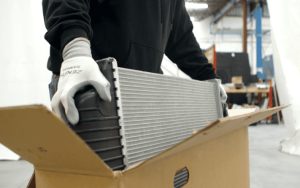A vehicle’s radiator plays one of the most important roles in its thermal management system. By transferring heat from the engine coolant to the outside air, the radiator helps maintain safe operating temperatures and prevents overheating. But as vehicles age or as drivers pursue performance enhancements, many face a common question: Should you stick with an OEM radiator or upgrade to an aftermarket performance unit?
This article examines how these two radiator types differ, what benefits each offers, and whether aftermarket radiators are worth the investment. For those considering an upgrade, you can Buy Radiator & Components online and compare options tailored to your specific vehicle.
What Is the Difference Between OEM and Aftermarket Radiators?

While OEM (Original Equipment Manufacturer) radiators are designed to meet factory specifications, aftermarket radiators come in a wide variety of designs — from direct replacements to high-performance multi-row and aluminum units.
Key Differences at a Glance
| Feature | OEM Radiator | Aftermarket Radiator |
|---|---|---|
| Material | Usually plastic tanks + aluminum core | Full aluminum, copper-brass, or enhanced composites |
| Cooling efficiency | Standard | Enhanced, often significantly |
| Tube & fin design | Basic | Enlarged tubes, multi-row, high-density fins |
| Price | Moderate to high | Wide range (cheap budget → premium performance) |
| Durability | Good | Varies greatly by brand |
| Best for | Standard driving | Towing, racing, tuned engines |
Advantages of OEM Radiators
OEM radiators are engineered specifically for your vehicle. Their design perfectly matches the original cooling requirements, making them reliable, predictable, and easy to install.
Key Benefits of OEM Radiators
-
Perfect fitment — No modifications needed
-
Factory-tested reliability
-
Balanced cooling for everyday driving
-
Long lifespan when maintained properly
-
Warranty-backed performance
OEM units are ideal if your car operates under normal conditions, you want trouble-free installation, and you prefer parts that meet factory standards.
Advantages of Aftermarket Radiators
Aftermarket radiators vary widely, but high-quality units offer several advantages over OEM options. Performance radiators are especially beneficial for high-heat scenarios, such as racing, towing, or driving in hot climates.
Key Benefits of Performance Aftermarket Radiators
-
Improved heat dissipation thanks to larger surface area
-
Thicker cores with multiple rows for increased coolant volume
-
Better materials such as full aluminum construction
-
Higher pressure resistance
-
Designed for high-load environments
-
Extend engine lifespan by reducing heat stress
These improvements can result in lower coolant temperatures and more stable engine performance under extreme conditions.
Types of Aftermarket Radiators
Not all aftermarket radiators are equal. Some are simple OEM-style replacements, while others are premium upgrades.
Common Types
-
OEM-Style Replacement Radiators
Affordable substitutes that match factory specs but may use cheaper materials. -
Two-Row or Three-Row Aluminum Radiators
Increased cooling capacity; ideal for performance applications. -
Copper-Brass Radiators
Excellent thermal conductivity but heavier and less common today. -
High-Density Fin Radiators
Provide maximum surface area for heat exchange.
When Is an Aftermarket Radiator Worth It?
Aftermarket radiators make sense in situations where heat management is crucial. Consider upgrading if you experience any of the following:
Signs You Need a Higher-Performance Radiator
-
Frequent overheating
-
Higher engine temperatures after tuning
-
Tow heavy loads or drive up steep gradients
-
Live in a hot climate
-
Regularly engage in racing, drifting, or spirited driving
-
Have a turbocharged or supercharged engine
Driving Situations Benefiting Most From Upgrades
| Driving Conditions | OEM Suitability | Aftermarket Suitability |
|---|---|---|
| Daily commuting | Excellent | Good |
| Highway travel | Excellent | Good |
| Mountain roads | Good | Excellent |
| Towing | Moderate | Excellent |
| Track driving | Poor | Excellent |
| Hot climates | Good | Excellent |
Potential Downsides of Aftermarket Radiators
While aftermarket radiators can offer superior cooling, there are a few downsides to keep in mind.
Possible Drawbacks
-
Cheap aftermarket units may use low-quality materials
-
Fitment issues due to non-standard dimensions
-
Higher cost for premium performance radiators
-
May require upgraded fans or shrouds
Choosing a reputable brand is essential to avoid reliability issues.
Cost Comparison
| Type of Radiator | Typical Price Range | Notes |
|---|---|---|
| OEM radiator | Medium to high | Reliable, supported by manufacturer |
| Budget aftermarket | Low to medium | May compromise build quality |
| Performance aluminum | Medium to high | Best cooling performance |
| Heavy-duty multi-row | High | Ideal for racing or towing |
Drivers should weigh long-term value rather than just the upfront cost, especially when engine health is at stake.
So… Are Aftermarket Radiators Worth It?

In many cases, yes, especially if your engine experiences above-average heat loads. Performance-oriented drivers, off-roaders, and those towing heavy loads often see significant improvements in cooling efficiency and overall engine stability with high-quality aftermarket radiators.
However, for everyday commuting and normal driving, a properly functioning OEM radiator is more than adequate.
If you’re considering a replacement or upgrade, explore your options and Buy Radiator & Components online to find high-quality parts that meet your needs.
Conclusion
Aftermarket radiators can offer outstanding benefits — improved cooling, better materials, and superior durability under stress. They are especially worthwhile for drivers who demand more from their engines. Yet OEM radiators remain a reliable choice for standard driving conditions.
Ultimately, the best radiator for your vehicle depends on your driving style, performance goals, and thermal demands. When chosen wisely, an aftermarket radiator can be a valuable upgrade that enhances both engine performance and longevity.